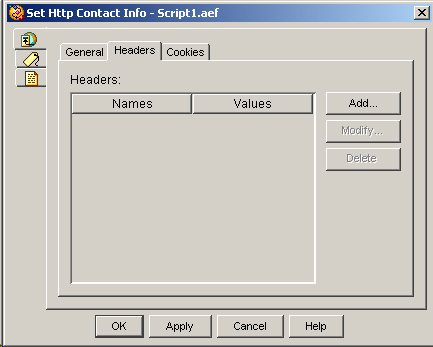Headers tab (Set Http Contact step)
Use the Headers tab of the Set Http Contact Info step to map each HTTP header to a local variable or a valid expression from which the header value will be obtained when the step executes.

HTTP headers contain general information such as the type of browser or the version of HTTP used. When you design a browser script, you can add information to the HTTP header to identify the HTTP version or browser type you are using.
You can also, for example, use this tab to control how long the browser maintains a cached copy of a document, by setting a value for the Expires header.
The following table describes the properties of the Headers tab of the Set Http Contact Info customizer window.
|
Property |
Description |
|---|---|
|
Headers (Names and Values) |
The Names of the headers and the corresponding variables that map to the headers. |
|
Add / Modify (buttons) |
Use these buttons to access the Header dialog box. Use the dialog to specify the following:
When done, click OK. |
|
Delete (button) |
To remove Header information, highlight a value in the list and click Delete. |
Add the HTTP Content-type header to explicitly specify the media-type and charset that is used to construct each HTTP response. If this is not set, the system will assign Content-type: text/html; charset=utf-8 header as the default value.
Note | The system also assigns X-Content-Type-Options: nosniff header to the response to prevent most of the browsers from overriding the specified content type. |